Even though your golf swing lasts just a couple of seconds, there is a lot of work to do in that time. Almost every part of your body has to play a role in the swing, from your legs providing stability and power to your hands accelerating the club through impact and everything in between. Not only do you need to make all of the right moves in order to deliver the club perfectly into the back of the ball, you also need to make these moves in the correct order. Only when you are able to sequence your swing properly time after time will you be able to achieve the level of consistency required to play great golf.
Why is the sequencing of your golf swing so important? It all has to do with the consistent acceleration of the club through impact. You don't want your swing to be fast during the backswing or early in the downswing – you want it to be fast at impact, when it matters most. In order to achieve great swing speed through the hitting area, you have to keep your mechanics in the proper order. Each part of the swing feeds the next, so having even one step out of place can ruin the entire process.
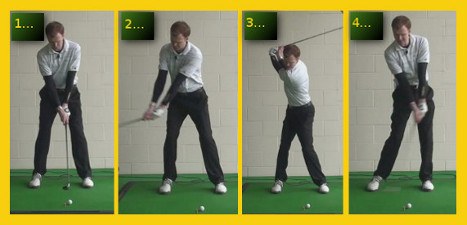
As you already know, the golf swing is a compilation of many different moves that all – hopefully – come together into a cohesive unit. Not only do you need to make all of the right moves during the swing, but you also need to make those moves in the right order. This is called sequencing, and it is extremely important. Only when you sequence your swing correctly can you expect to produce quality results swing after swing.
This article will take a detailed look at how golf swing sequencing works. While golf swing tempo will vary quite a bit from player to player, the basic sequencing of the swing should be pretty similar across the board. It’s likely that things in your swing aren’t quite in sequence right now, but don’t worry about it. Many golfers struggle with this part of the game, so just get down to work and look forward to hopefully making great strides in the near future.
All of the content below is based on a right-handed golfer. If you happen to play left-handed, please reverse the directions as necessary.
— The Importance of Sequencing
So, why does sequencing matter at all? It’s important to answer this question first, as you will only have the motivation you need to work on your sequencing if you properly understand why it is so important. In this section, we’d like to highlight three key points that underscore just how important it is to sequence your swing correctly.
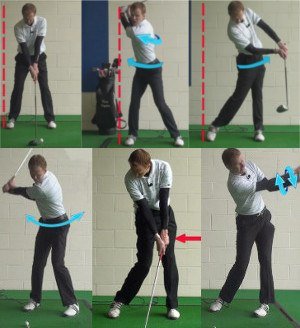
- Maximizing power. This is a big one, so we might as well start on this point. If you would like to hit the ball as hard as possible – and who wouldn’t – you are going to need to sequence your swing correctly. Sequencing is directly related to power because a swing that unfolds in the right order is a swing that is more likely to lead to optimal power output. Unfortunately, many amateur golfers get the sequence of their swing wrong, and they wind up wasting power as a result. We’ll get into the details of proper sequencing later in the article, but for now just understand that doing things in their correct order is one of the best things you can do for adding power and speed. If you feel like you are capable of producing more power in your game than you are currently seeing on the course, improving your sequencing might be that big breakthrough that you’ve been needing.
- Consistent ball striking. One of the great challenges in this game is hitting the ball solidly swing after swing. Every golfer knows the frustration of hitting the ball nicely on one shot – only to hit a terrible shot on the next attempt. There will always be some level of inconsistency built into this game – it’s a hard game, after all – but you can improve in this area if you dial in your sequencing. With everything in your swing happening in the right order, it will become easier to deliver the club to the back of the ball cleanly time after time. Also, you’ll notice that your swing holds up better under pressure when you use proper sequencing, which is important if you have any desire to play in golf competitions. It’s a great feeling to stand over the ball confident in your ability to hit a clean shot, and good sequencing can take you much closer to that goal.
- Open up new possibilities. Another of the many benefits associated with good sequencing is the opportunity to hit new kinds of shots. If your current swing is out of sequence, you might have found a way to make it work reasonably well for you – but you can probably only hit one type of shot out of that swing. For instance, you may have learned how to hit a controlled fade, but you simply can’t hit a draw. You can use that playable fade to get around the course, but you’ll always be limited by your inability to turn the ball over. With a swing that is correctly sequenced, you should be better able to adapt your shots to the situation at hand. It will still take plenty of practice on the driving range to learn new shots, of course, but a well-sequenced swing will give you a fighting chance.
| GOLF FIXES BY PGA PROS |
|---|
| Get The Correct Golf Swing Sequence To Improve Balance | Video | Article |
| Getting The Sequence Of The Golf Backswing Correct | Video | Article |
| What is the Right Golf Swing Sequence | Video | Article |
| What is the Correct Golf Swing Sequence | Video | Article |
| How To Make Sure You Have A Good Swing Sequence | Video | Article |
| What is the Correct Right Arm Swing Sequence | Video | Article |
| What is the Correct Right Arm Swing Sequence From Start to Finish | Video | Article |
| Get The Correct Golf Swing Sequence To Improve Balance | Video | Article |
| What is the Right Golf Swing Sequence Women Golfer Tip | Video | Article |
| Getting The Sequence Of The Golf Backswing Correct | Video | Article |
| LESSONS |
|---|
| David Toms Pro Golfer, Swing Sequence | Video | Article |
| Jim Furyk Pro Golfer, Swing Sequence | Video | Article |
| Rich Beem Pro Golfer, Swing Sequence | Video | Article |
| The Sequence Of The Hip Movement During The Golf Swing | Video | Article |
| Dustin Johnson Pro Golfer, Swing Sequence | Video | Article |
| K J Choi Pro Golfer, Swing Sequence | Video | Article |
| Ricky Fowler Pro Golfer, Swing Sequence | Video | Article |
| Tiger Woods Pro Golfer, Swing Sequence | Video | Article |
| Ernie Els Pro Golfer, Swing Sequence | Video | Article |
| Keegan Bradley Pro Golfer, Swing Sequence | Video | Article |
| Tim Clark Pro Golfer, Swing Sequence | Video | Article |
| Flipping The Sequence For The Golf Downswing | Video | Article |
| Kyle Stanley Pro Golfer, Swing Sequence | Video | Article |
| Todd Hamilton Pro Golfer, Swing Sequence | Video | Article |
| Fred Couples Pro Golfer, Swing Sequence | Video | Article |
| Lee Trevino Pro Golfer, Swing Sequence | Video | Article |
| Rory McIlroy Pro Golfer, Swing Sequence | Video | Article |
| Tommy Gainey Pro Golfer, Swing Sequence | Video | Article |
| Geoff Ogilvy Pro Golfer, Swing Sequence | Video | Article |
| Lorena Ochoa Pro Golfer, Swing Sequence | Video | Article |
| Sam Snead Pro Golfer, Swing Sequence | Video | Article |
| Trevor Immelman Pro Golfer, Swing Sequence | Video | Article |
| Gary Woodland Pro Golfer, Swing Sequence | Video | Article |
| Louis Oostheizen Pro Golfer, Swing Sequence | Video | Article |
| Scott Stallings Pro Golfer, Swing Sequence | Video | Article |
| Using Balance To Understand If Your Golf Swing Sequence Is Correct | Video | Article |
| What is the Correct Right Arm Swing Sequence From Start to Finish | Video | Article |
| Matt Kuchar Pro Golfer, Swing Sequence | Video | Article |
| Sergio Garcia Pro Golfer, Swing Sequence | Video | Article |
| Vijay Singh Pro Golfer, Swing Sequence | Video | Article |
| Michelle Wie Pro Golfer, Swing Sequence | Video | Article |
| Steve Flesch Pro Golfer, Swing Sequence | Video | Article |
| Adam Scott Golfer, Pro Swing Sequence | Video | Article |
| Mike Weir Pro Golfer, Swing Sequence | Video | Article |
| Stewart Cink Pro Golfer, Swing Sequence | Video | Article |
| Adam Scotts Professional Golfers Swing Sequence | Video | Article |
| Hunter Mahan Pro Golfer, Swing Sequence | Video | Article |
| Natalie Gulbuis Pro Golfer, Swing Sequence | Video | Article |
| Stuart Appleby Pro Golfer, Swing Sequence | Video | Article |
| What Is The Golf Swing Sequence | Video | Article |
| Angel Cabrera Pro Golfer, Swing Sequence | Video | Article |
| Todd Hamilton Pro Golfer, Swing Sequence | Video | Article |
| Fred Couples Pro Golfer, Swing Sequence | Video | Article |
| Lee Trevino Pro Golfer, Swing Sequence | Video | Article |
| Rory McIlroy Pro Golfer, Swing Sequence | Video | Article |
| Tommy Gainey Pro Golfer, Swing Sequence | Video | Article |
| Gary Woodland Pro Golfer, Swing Sequence | Video | Article |
| Geoff Ogilvy Pro Golfer, Swing Sequence | Video | Article |
| Lorena Ochoa Pro Golfer, Swing Sequence | Video | Article |
| Sam Snead Pro Golfer, Swing Sequence | Video | Article |
| Trevor Immelman Pro Golfer, Swing Sequence | Video | Article |
| Louis Oostheizen Pro Golfer, Swing Sequence | Video | Article |
| Scott Stallings Pro Golfer, Swing Sequence | Video | Article |
| Using Balance To Understand If Your Golf Swing Sequence Is Correct | Video | Article |
| Matt Kuchar Pro Golfer, Swing Sequence | Video | Article |
| Sergio Garcia Pro Golfer, Swing Sequence | Video | Article |
| Vijay Singh Pro Golfer, Swing Sequence | Video | Article |
| A Great Golf Downswing Is All About The Sequencing | Video | Article |
| Losing Distance Due to Poor Sequencing | Video | Article |
| PRACTICE DRILLS |
|---|
| Right Hand Golf Tip: What is the Proper Foot Work Sequence from Address to Full Finish | Video | Article |
| Right Hand Golf Tip: How and Why You Should Create a Good Sequence Golf Swing | Video | Article |
| Great Drill To Improve Golf Swing Sequence | Video | Article |
| Right Hand Golf Tip: How and Why You Should Create a Good Sequence Golf Swing | Video | Article |
| Use Correct Sequencing To Avoid A Pulled Golf Shot | Video | Article |
Safe to say, you have a lot to gain by dialing in the sequencing of your swing just right. Is golf suddenly going to become easy once all of the parts of your swing are working together correctly? Not by a long shot. This will remain a hard game no matter what you do with your technique. However, with an orderly swing that is ready for the challenge that the course presents, you’ll have an opportunity to breakthrough to a new level of play.
— What It Should Look Like
At this point, we are going to get down to the business of highlighting how your swing should be organized. If you have never quite been sure of what should happen when, and how it should all fit together, this section is for you. As you read through this section, understand that you are probably making some mistakes currently – and that’s okay. For now, we are just focused on building an understanding of how it should work. Later, we’ll talk about common mistakes and what you can do to fix them.
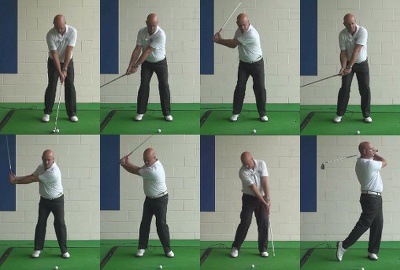
- Address position. Each shot starts with a solid address position. While your stance will look a little different from shot to shot depending on the club you are using and the lie of the ball, the basics should remain steady. You’ll want to flex your knees, keep your back straight, your chin up, and your arms hanging in a relaxed manner from your shoulders.
- The first move. To get the swing started, you’ll need to move the club back away from the ball. That much is obvious. But what parts of your body do you use to put the club in motion? Ideally, you will turn your shoulders away from the target to get the club started, while your hands and wrists stay quiet. This is where many golfers go wrong, as it’s common for players to get their hands involved too early. Resist this temptation if at all possible. To start your swing, simply turn your shoulders away from the target while remaining in a comfortable, athletic position with your lower body. There will be plenty of time for your hands to get involved later, but the start of the swing should be performed by shoulder rotation.
- Up to the top. As the backswing continues, it’s going to be more of the same from your takeaway. In other words, you need to keep turning your shoulders to move the club into position. Yes, you can start to involve your hands and wrists in the later stages of the backswing to set the club, but it is still your shoulder turn that is the main driver of this action. If you do a good job of turning your shoulders, the club and your body should both be in a great position when the backswing is complete.
- The transition. This is really where things start to get interesting – and where things often go wrong. The ‘transition’ phase of the golf swing is where the backswing turns into the downswing, and it’s a critical moment in the success or failure of your action. A good transition will send you down toward impact in great shape. On the other hand, a mistake here will leave you without enough time to recover. It’s not an exaggeration to say that the transition can make or break your swing. To get through the transition successfully, you want to allow the lower body to lead the way. In other words, your lower body should be the first thing to switch directions and start moving toward the target. That initial move is going to be a rotation to the left with your hips – it might help to think about opening your left hip up to the target. That move is not so tricky by itself, but it’s the timing of the move that gives people trouble. Ideally, you will put your hips in motion toward the target before the club even reaches the top of the backswing. In this way, there should be some ‘overlap’ between your backswing and your downswing. While the club is finishing its journey to the top, your lower body is already getting started on the job of making a powerful downswing. If you have ever wondered how professional golfers are able to hit the ball so hard while making smooth swings, this is the ‘secret’. They overlap the backswing and downswing, so the finished product looks like one easy, continuous action.
- The rest of the downswing. Getting through the transition successfully is a huge step on the way to a solid shot. Unfortunately, things can still go wrong, so you need to pay attention to your technique down through impact and into the finish. On the way down, you want to make sure that your body is turning through the shot while the hands hang back and wait for their turn to get involved. What started with a rotation of the lower body will soon involve the rest of your body, which is how you can build up power for the moment of impact. Allow that turn to happen aggressively while you resist the temptation to let your hands get involved too early. Basically, the club is going to be the last thing to turn through the ball. If you can get your body through first and let the club hang back, it’s possible to create impressive speed that will send the ball well off into the distance.
- The moment of impact. Some golfers seem to be under the misguided notion that they need to actively release the club with their hands at impact. That’s not really how it works. Ideally, the rotation of your body will bring everything into position, and you won’t need to consciously think about the release action of your hands. In fact, if you are trying to actively release your hands, it’s going to be tough to make that happen at just the right time. Impact only lasts for a fraction of a second, so you are almost sure to be a little early or late if you are doing it consciously. Instead, you should be trusting the aggressive body turn you are making to bring the club down into the ball in just the right spot.
- Into the finish. It might not seem like the finish of the golf swing would be particularly important, since the ball is already gone, but there is a lot you can learn from the finish. Since your lower body led the way in the downswing, it’s a good sign so see your lower body arrive at its finished position first, with the club coming in last in this ‘race’ to the finish. If you notice that the club is getting all the way through and into the finish before the rest of your body, that is a likely sign that something is wrong.
In the end, the sequencing of your golf swing isn’t particularly complicated – but it is critical that you get it right. We hope that this section has brought some clarity to the task, and you now feel informed enough to work on this skill in your own game. In the next section, we’ll touch on some of the mistakes that may be standing in your way.
— Common Mistakes
It’s easy to fall into a negative frame of mind in this game. As you start to work on the finer details of your swing, you might feel a bit dejected about all the work you have in front of you. Try to avoid that feeling, as it is normal for virtually every golfer. In fact, you can see this as an opportunity – if you are able to make changes to your game, you can look forward to lower scores in the future.
The list below highlights common golf swing sequencing mistakes. As you read, think carefully about your swing to determine whether or not you are currently making any of these errors.
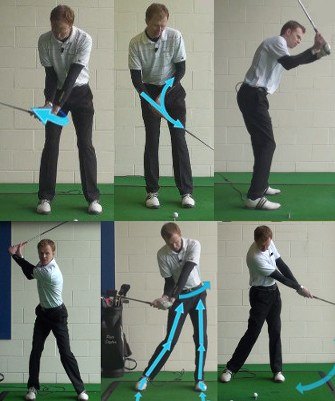
- Starting with the hands. We alluded to this one in the previous section, and it is an extremely common issue. When it’s time to start your swing, you might feel like the best way to go is to initiate the action with your hands and wrists, rather than your shoulders. This move does feel powerful to some players, and you might have habits left over from other sports where the hands are used more actively. On this issue, we have one piece of good news, and one piece of bad news. The good news is it should be pretty easy to figure out whether or not you are making this mistake. Simply practice your takeaway a few times and pay close attention to what it is that’s causing the club to move. If it is your hands rather than your shoulders, there is a problem to address. As far as the bad news, this mistake is notoriously difficult to fix. It might seem simple, but changing to a shoulder-based takeaway is going to alter the feel of your entire swing, so plenty of practice work will be required to get comfortable.
- Rushing the backswing. At first, it might not seem like this point would have much to do with sequencing. After all, couldn’t you rush through the backswing and still do everything in the right order? Technically, yes, you could, but it’s tough to do. Typically, when golfers rush through the backswing, they struggle to get their sequencing right. The issue comes down to having trouble starting the downswing with the lower body. When the swing is rushed, it’s hard to get the lower body going in time, so it’s usually the hands rather than the legs that are the first thing to start forward. That’s a problem, and it leads to a weak swing that may result in a slice. Have you ever noticed that most golfers who hit a slice seem to swing rather quickly? That’s not a coincidence – that rushed tempo is a major contributor to the slice pattern.
- A tentative lower body move. To make this sequencing plan work out properly, you have to be fully committed once the downswing begins. If you start with the lower body from the top, but then give up on that move partway through the downswing, all will be lost, and the results will be disappointing. Like with everything in golf, you have to be fully and truly committed to your swing each time you take the club back away from the ball. Sure, not all of those swings are going to work out as you would like, but that’s not the point. By fully committing, you will give yourself the best possible chance for success, and you should see your percentage of quality swings improve.
If you are struggling with your sequencing, it’s quite likely that at least one of the issues above is present in your game. Take some time during an upcoming practice session to review your technique and see if you can determine exactly where things are going wrong.
— Is There Sequencing in the Short Game?
To wrap things up, we need to quickly talk about the short game and whether or not sequencing plays a role in that area. For the most part, sequencing is not going to matter in the short game – or, at least, not to the extent that it matters in the long game. You still need to do things in the right order, but it will be much easier to do so here than when you are making your full swings.
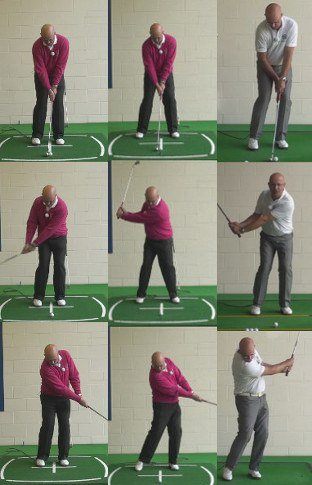
When putting, there isn’t much to think about as far as the sequence of the stroke, since the putting stroke should just be one collected motion. Ideally, you’ll just be rocking the putter back and through by moving your shoulders together in a single piece. When that happens, you don’t have to worry about sequencing, because there is only one move taking place. There is no order of operations, in other words, because the stroke is so simple. If that’s not how your putting stroke is working currently, the problem lies with your technique rather than your sequencing.
For chip shots, the same basic conversation applies. Yes, chip shots are a little more complicated than putts from a technique perspective, but not dramatically. You might engage your hands and wrists a little bit on a chip shot, depending on what kind of shot you are hitting, but the main driver of the swing will still be shoulder movement. So, in the end, sequencing is not something that should come into play in a major way when chipping.
One area of the short game where you might need to think a bit about sequencing is with bunker shots. When playing greenside bunker shot, you’ll need to make a big swing that isn’t much different from what you do when hitting full shots. However, the lower body should not move as aggressively on an explosion shot. So, many of the same sequencing rules still apply, but don’t worry about getting your lower body to lead the way so dramatically. As long as you make a good shoulder turn and rotate through the shot, you should be in pretty good shape.
Improving your swing sequencing is one of the biggest ways to take your game to a higher level. With that said, it’s not going to be easy to make improvements here, and you’ll likely struggle for a while before you start to break through. Give yourself plenty of time and be patient during your practice sessions.






